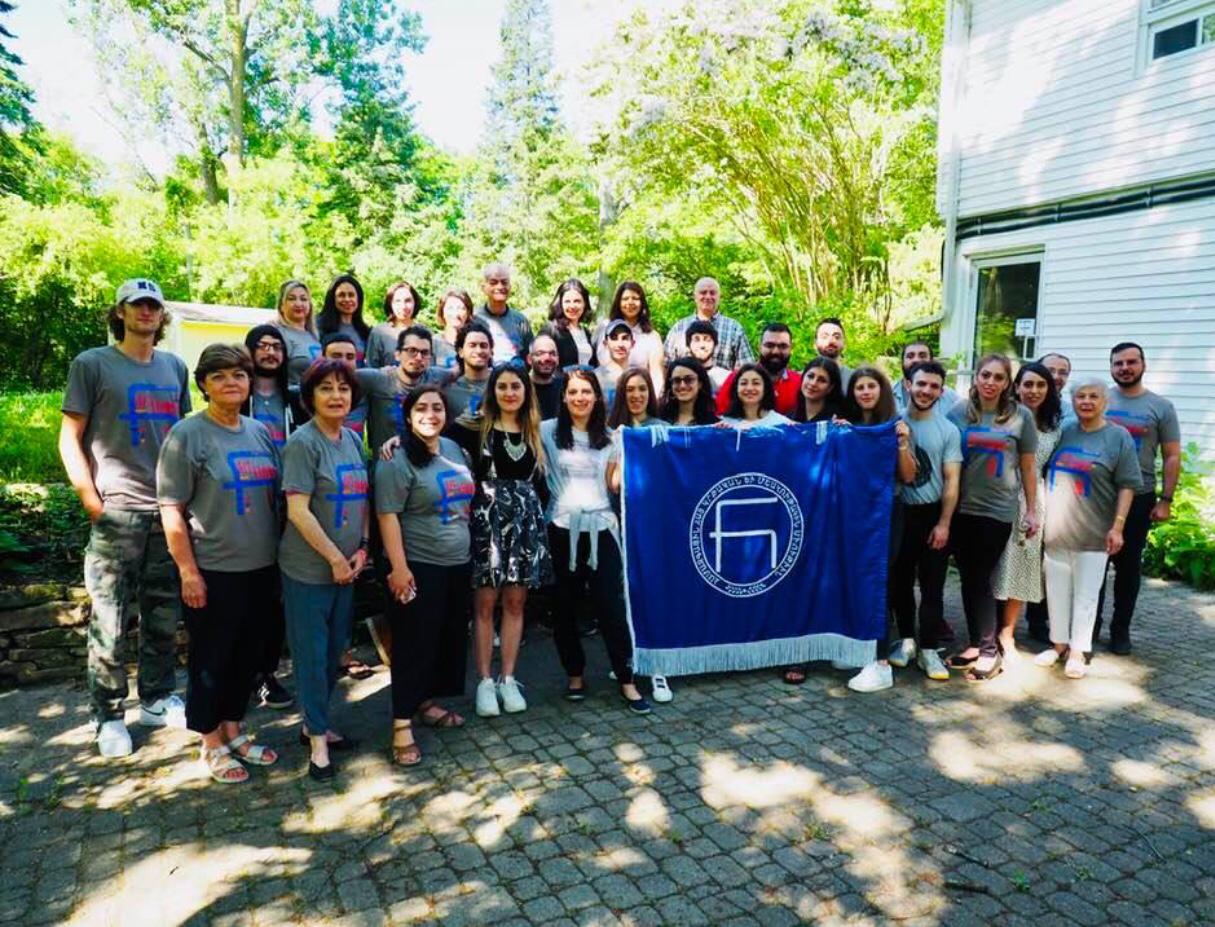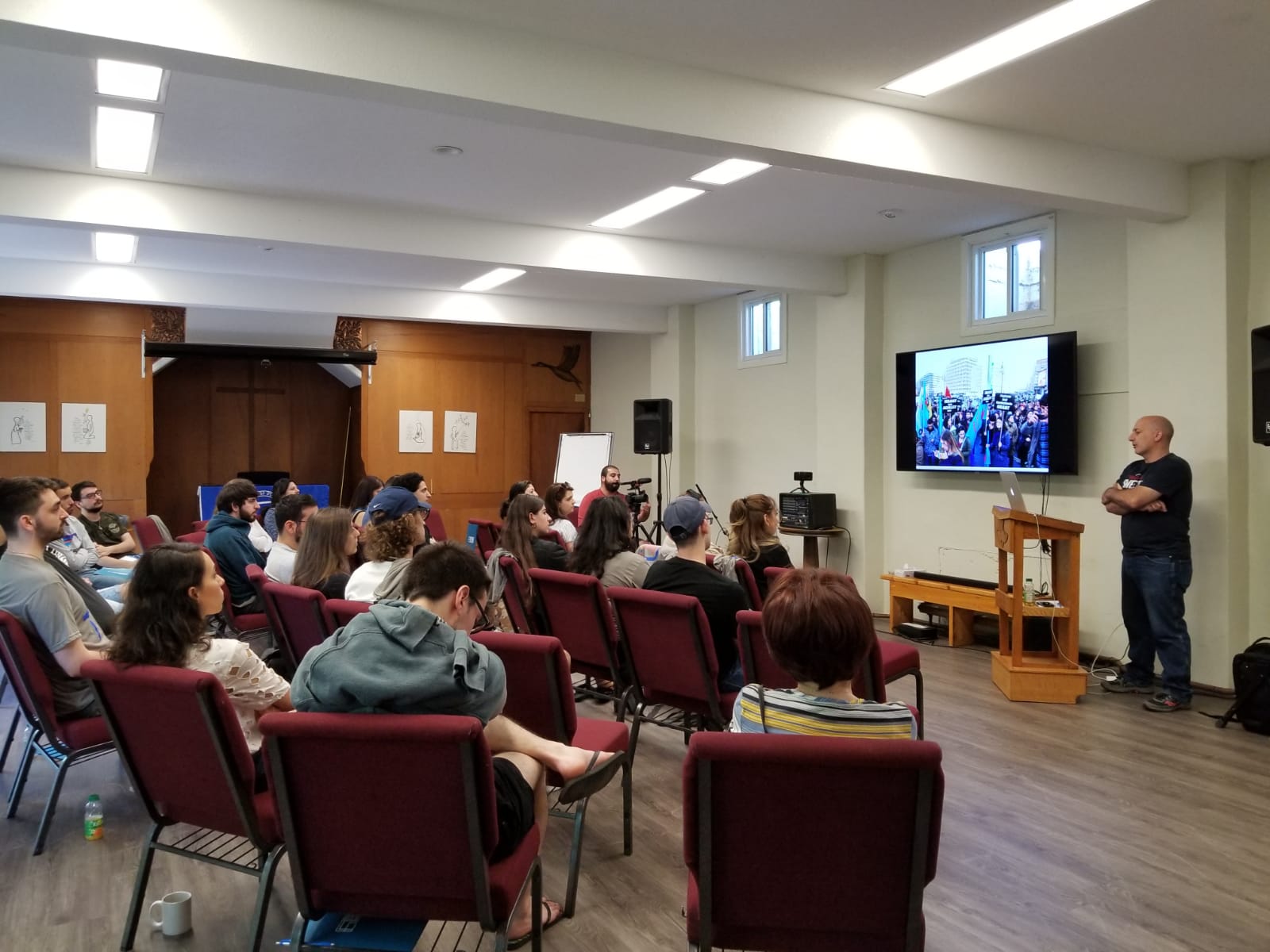
It’s hard to believe that there ever was a time when the Hamazkayin ArtLinks retreat program didn’t exist. Since 2015, for just three whirlwind (some would say, sleepless) summer days, dozens of young Armenians from across the U.S. and Canada flock to a secluded location in North America to immerse themselves in all things art, culture, identity, music, literature, poetry, dance, song and any other creative outlet you could think of.
The program, organized by the Hamazkayin Western Region, Eastern Region and Canada Regional Boards, aims to foster interest in the fields mentioned above for the next generation of Diasporan Armenians, as well as to encourage said group to lend their voices, bodies and minds towards the creation of a new Diasporan Armenian experience. Established leaders in these fields lead interactive workshops on various topics and themes regarding Armenian art, culture and identity. The result is nothing short of extraordinary.
This year, the fifth installment of the program was held at a retreat center in the quiet forested town of Paris (not that Paris), an hour outside of Toronto, Canada, from June 20 to 23. On the schedule was a discussion on Armenian genealogy with one of the foremost experts in this field, George Aghjayan; a creative writing workshop with Harvard University lecturer, Dr. Lisa Gulesserian; a music session with pianist and music director Anna Mikaelian; a film workshop with Academy Award-nominated director Atom Egoyan; and a dialogue on Armenian identity with scholar and educator Dr. Viken Tufenkjian.
Though the age range for participants is officially listed as 21 to 35, this year’s participants skewed a little on the older side, with most in their mid-to-late 20s. This fact, in and of itself, is not so important until you hear them rattle off their vocations: independent filmmakers, designers, musicians, voice actors, makeup artists, comedy screenwriters—the caliber of this year’s list was so incredible, that pretty much all of the participants could have also served as workshop leaders.
And that is the point. ArtLinks program director Dr. Khatchig Mouradian has repeatedly said that the structural nature of ArtLinks is horizontal, not vertical. The word “lecture” is nowhere to be heard at any point throughout the weekend. Workshop leaders engage with participants in a relaxed, informal way, and most of them spend the entire weekend at the retreat with the group, discussing, bonding, playing and jamming at all hours of the day (and often, into the late night).
The weekend program began early on Thursday evening. Admittedly, my friend and fellow four-time ArtLinks alum Helena Bardakjian and I strolled into the retreat center quite late, missing the formal introductions. Perhaps it was for the best since everyone had already done the tough task of breaking the proverbial ice. We were greeted with cheers by fresh and familiar faces alike; all were gathered around the couches in the entrance hall, drinking and chatting like close buds. ArtLinks had begun.
Day One: Growing through Art
The next morning, Dr. Mouradian kicked off the official start of the program by introducing Aghjayan, Director of the Armenian Historical Archives and an expert in the demographics and geography of Western Armenia. His passion project has been to educate other Armenians on modern genealogy and DNA testing so that they, too, can find their lost branches and repair their family trees. In the days leading up to ArtLinks, he generously offered to do some research for others, and he went over some of his findings during the workshop.

When the conversation turned to Hidden Armenians—Armenians who were “left behind” during the Genocide and forcibly converted to Islam—Aghjayan got emotional. Looking around the room, one could feel the weight of his words seeping into the hearts of these young Armenians, who realized—in that moment—that all that separated them from those “strangers” was a momentary fluke in history—that they, too, could have been among the “hidden.”
During the lunch break, participants, lecturers and organizers mixed and mingled, chatting about the morning’s workshop and, like a family tree, different conversations sprouted as offshoots. The workshops then continued with Dr. Gulesserian. For the past two years, Dr. Gulesserian has been the Armenian lecturer at Harvard University. Her efforts—modern, innovative, hip and inviting—have propelled Armenian activities at the school to new heights. No doubt, she would bring that same excitement to ArtLinks. In the beginning of her presentation, one could sense some trepidation from the crowd (admittedly, I was among that group). A nearly two-hour discussion on Armenian poetry seemed daunting, even to the most astute Armenian student.

We learned about the hayren, an Armenian poetry style from the 13th century, which saw its heyday in the 16th century. We read and analyzed examples from Nahapet Kuchak, a medieval Armenian monk who pushed the boundaries of the cultural and societal norms of his time. The symbolism of selecting the works of a man who challenged dogma and feudalism did not evade our group. After some fun exercises of decoding and analyzing existing hayrens, then putting together one as a group, the tension in the room eased. Just as we were getting comfortable, our leader told us that during tomorrow’s session, we will all compose our own hayrens (in whichever language we feel most comfortable) and present them to our peers. Anxiety levels shot back up.
After a short break, the program resumed outside, with Anna Mikaelian, founder and executive director of Armenia’s Nexus Center for the Arts, which provides all children—regardless of background or socio-economic status—a quality musical education. Our group formed a wide circle and, handed nothing but a few makeshift instruments, began to create music together. Mikaelian facilitated by providing a rhythm or a beat and told us to listen to each other, to follow each other and to silence the filters that tell us how something should sound. After a little struggling, the vibe slowly changed. Getting out of our own heads, we were able to transcend our insecurities and enter a space of unison—if only for a brief, fleeting moment.
Day Two: From Anxiety to Authenticity
The second day of the program began with another poetry session. Dr. Gulesserian reminded us of the simple structure of the hayren—four lines of 15 syllables each—and set us off to compose our own. If only writing one were as simple as the structure itself! We were given 15 minutes to compose our masterpieces, and then received feedback on them from our small groups of three; ultimately, though, the exercise was a solo activity.
After immersing ourselves in the “ego,” we shifted gears with the second music workshop. Mikaelian announced that we would be recording an improvisational song—as a group. But participants struggled to find the rhythm and “harmony” their leader was searching. By the end, it seemed like everyone had given up trying.
The truest skill—some would say “gift”—of an artist is the act of listening. Writers, musicians, dancers: they all observe and listen. To other voices, bodies and words. To their own voices, bodies and words. Judgment, insecurity and hesitation have no space in this equation. Perhaps the true lesson of both activities was to get us out of our own heads and just listen to the voices around us and within us.
Unfortunately, due to a family death, Atom Egoyan and his wife, actress Arsinee Khanjian, were not able to make it to the ArtLinks program. However, their time slot was not wasted. Everyone filled it with something that brought them joy—some played soccer and frisbee outside, others went for a hike on the picturesque trail that cut through our retreat center, one group chose to cool down in the swimming pool on site, and a few others elected to resume the morning’s music session.
What ensued was a three-hour non-stop musical journey, where Armenian folk tunes like “Sareri Hovin Mernem” and “Garun A” by Komitas served as the seeds for an improvisational journey that crossed genres and that pesky, ever-present mental barrier. By the end of it, nearly everyone was in tears. Anxiety washed away, and out came our truest selves. What the morning’s session failed to do, this one made up for—and then some.
In the evening, many participants gathered in the entrance hall to watch Egoyan’s “Calendar,” which was shot in newly-independent Armenia in 1993. After the screening, a lively discussion developed about the various themes presented by Tufenkjian, especially the concept of identity, which the main character struggled with deeply. One of the ArtLinks organizers from Montreal, Salpy Markarian, shared an anecdote of how she accompanied her husband, photographer Norayr Kasper, to the film set in Armenia. At the time, she was pregnant with their son, Arshen, a two-time ArtLinks participant. The world is small, but even smaller for Armenians.
Call me biased, but I was giddily excited for the last session. Tufenkjian, one of the organizers and most ubiquitous faces at ArtLinks, gave a talk on Armenian identity. His question of “who or what is the Armenian?” raised more questions than answers—which, as any professor or scholar would try to reassure you, is actually a good thing. He listed eight elements integral to “Armenianness,” assigned us to groups and asked us if we could rank them in a hierarchy. I remembered Dr. Mouradian’s words: that ArtLinks is a lateral program, that we do not rank people—that everyone here (even the PhDs) preferred to be called by their first names. This was perhaps the most “vertical” moment of the entire program—and coming right at the very end, no less! It caught most of us off guard, but again, maybe that was the point?
What is Armenianness? Who is (the) Armenian? Who gets the right to decide? How does one measure these elements anyway? What about the exceptions? Indeed, could there ever *be* exceptions? Here, Mr. Aghjayan’s voice was in my head. His plea to welcome hidden Armenians into the fold, to embrace them as our long-lost relatives, not to shun their chosen identities—kept ringing as the angel to the devil who wished to conquer and divide—to say that one must be this, do this, work towards this, in order to be “Armenian.” That there have to be “standards.”
The conversation rolled over nicely to my impromptu presentation on h-pem, another Hamazkayin initiative, a new online platform which aims to present Armenian arts and culture in an innovative way for a young diasporan audience, as well as to create a space for emerging and established Armenian artists from across the globe to meet, discuss and present their works. Our defining mantra is that Armenianness is not so easily defined—it shifts and ebbs and means different things to different people. Indeed, Armenianness to me could be radically different than Armenianness to you. Like the hayren and harmony exercises, we fear the unfamiliar, and on some level, are afraid that we, ourselves, can never measure up to our own “standards.” Reckoning with that can seem daunting—scary, even—but it can also be very beautiful.
In previous years, I have noted that ArtLinks is a space that welcomes, respects and accepts young Armenians who may not fit the neat mold of Armenianness or the conceptualized diasporan. But this year, I realized that it goes even deeper than that. ArtLinks is one of just a few places—let alone, Armenian places—where authenticity reigns supreme. Just as much as it is a forum to learn about Armenian art and culture and network with others in those fields, it is also an opportunity to form authentic connections with people; to reflect on the raw truths of our inner selves, our identities and our family stories; and to marry art and pain and history in creative, innovative and deeply intentional ways. Just two weeks after this year’s program ended, one of my friends commented that she did not want this “aura of authenticity” to go away. We’re all holding on until next year.
ArtLinks 2020 will be in the Los Angeles area. We’ll see you there!



Pure joy. Makes me want to be young again!